Assessment Item 3: Economic Issues Written Analytical Report
VerifiedAdded on 2020/05/11
|8
|1787
|333
Report
AI Summary
This report provides a macroeconomic analysis of the Australian economy, focusing on the relationship between interest rates, business investment, and aggregate demand. The study begins by examining the impact of the Reserve Bank of Australia's (RBA) monetary policy, specifically the reduction of interest rates, on business investment. It explains how lower interest rates encourage investment and stimulate economic growth, supported by the IS-LM model. The report then explores the components of aggregate demand, including consumer spending, investment spending, government spending, and net exports. It analyzes how changes in business investment affect aggregate demand in both the short and long run, using examples and graphical representations to illustrate the concepts. The conclusion summarizes the negative correlation between interest rates and business investment and the positive relationship between business investment and aggregate demand. The report references various macroeconomic theories and studies to support its analysis.
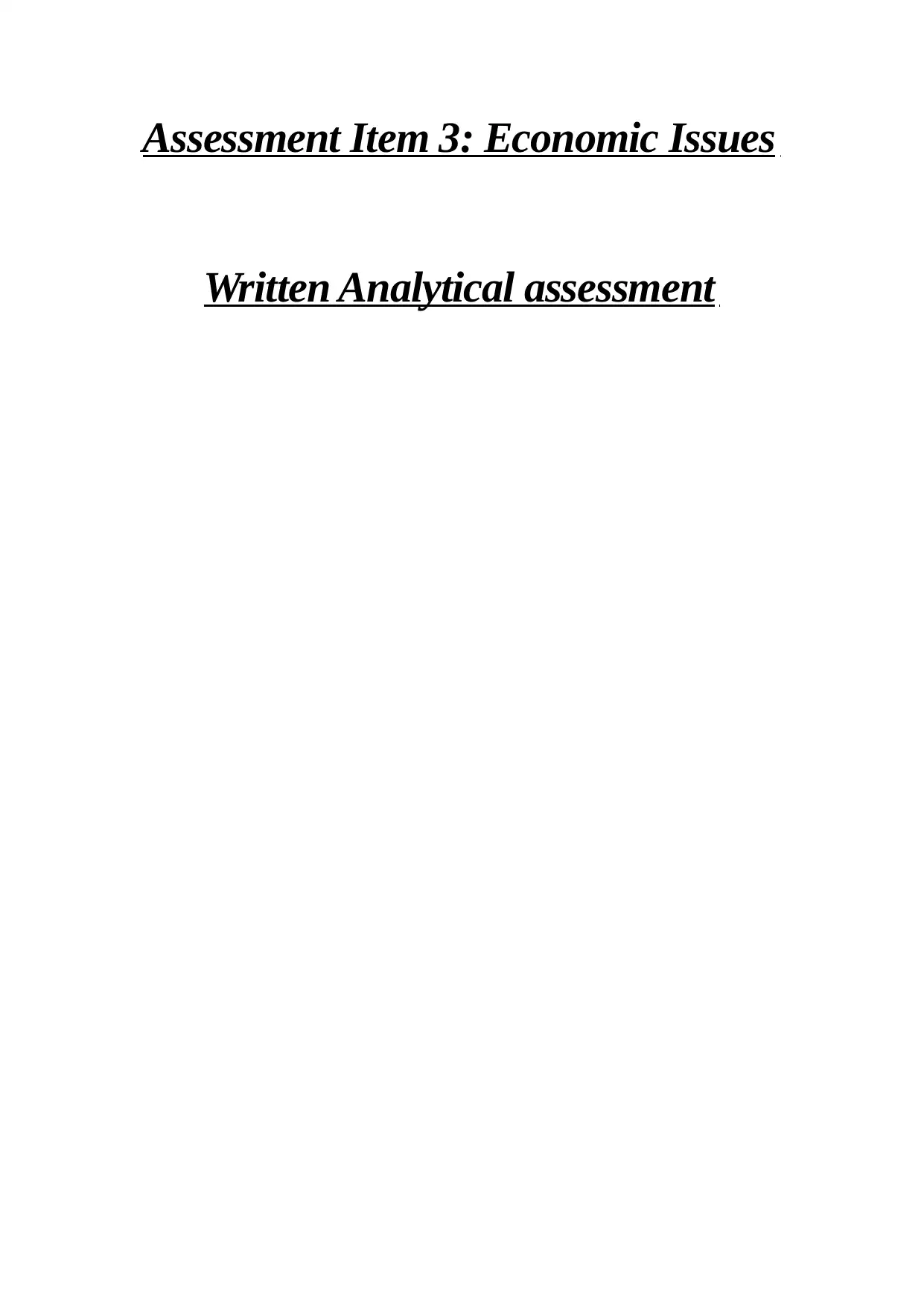
Assessment Item 3: Economic Issues
Written Analytical assessment
Written Analytical assessment
Paraphrase This Document
Need a fresh take? Get an instant paraphrase of this document with our AI Paraphraser
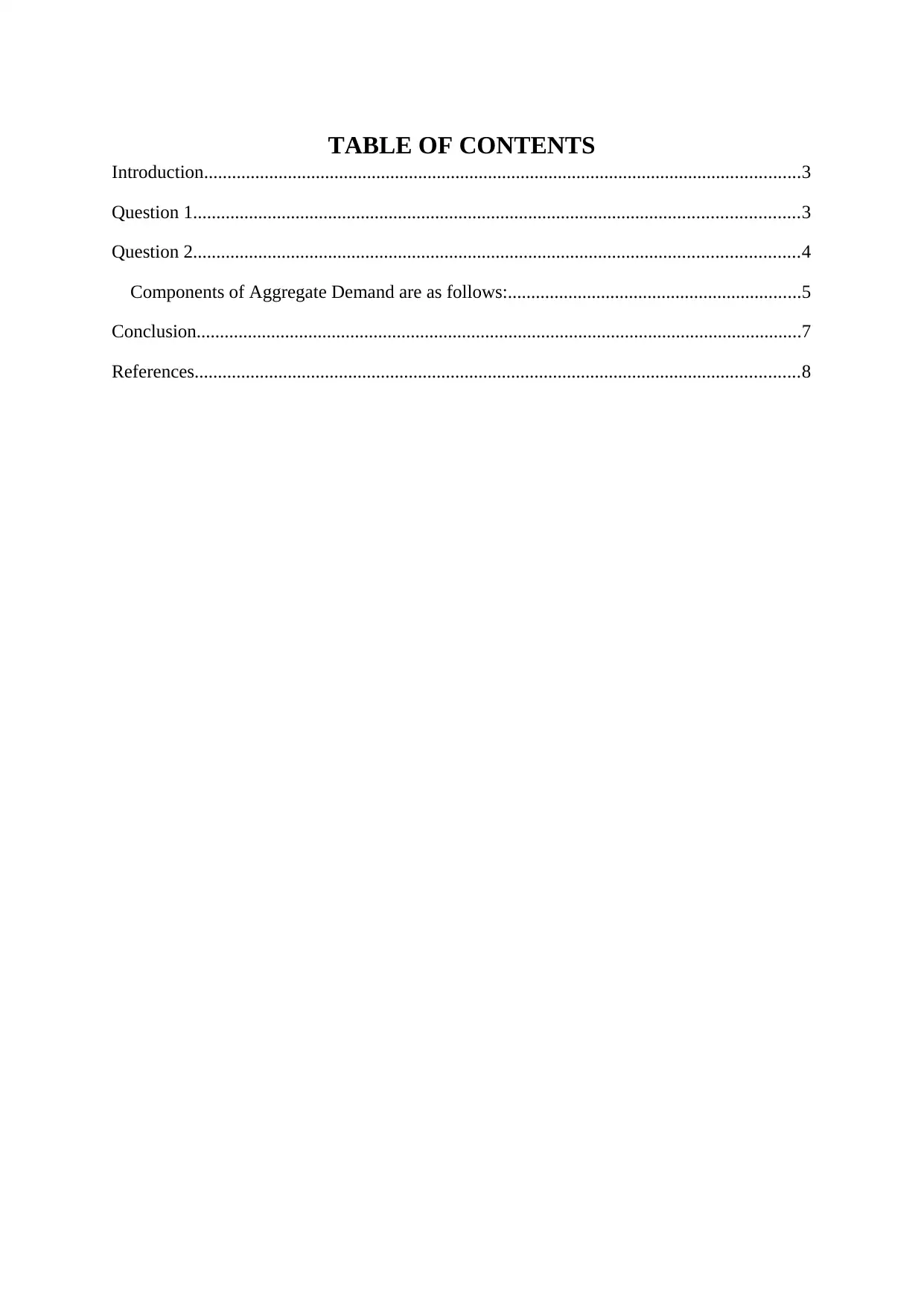
TABLE OF CONTENTS
Introduction................................................................................................................................3
Question 1..................................................................................................................................3
Question 2..................................................................................................................................4
Components of Aggregate Demand are as follows:...............................................................5
Conclusion..................................................................................................................................7
References..................................................................................................................................8
Introduction................................................................................................................................3
Question 1..................................................................................................................................3
Question 2..................................................................................................................................4
Components of Aggregate Demand are as follows:...............................................................5
Conclusion..................................................................................................................................7
References..................................................................................................................................8
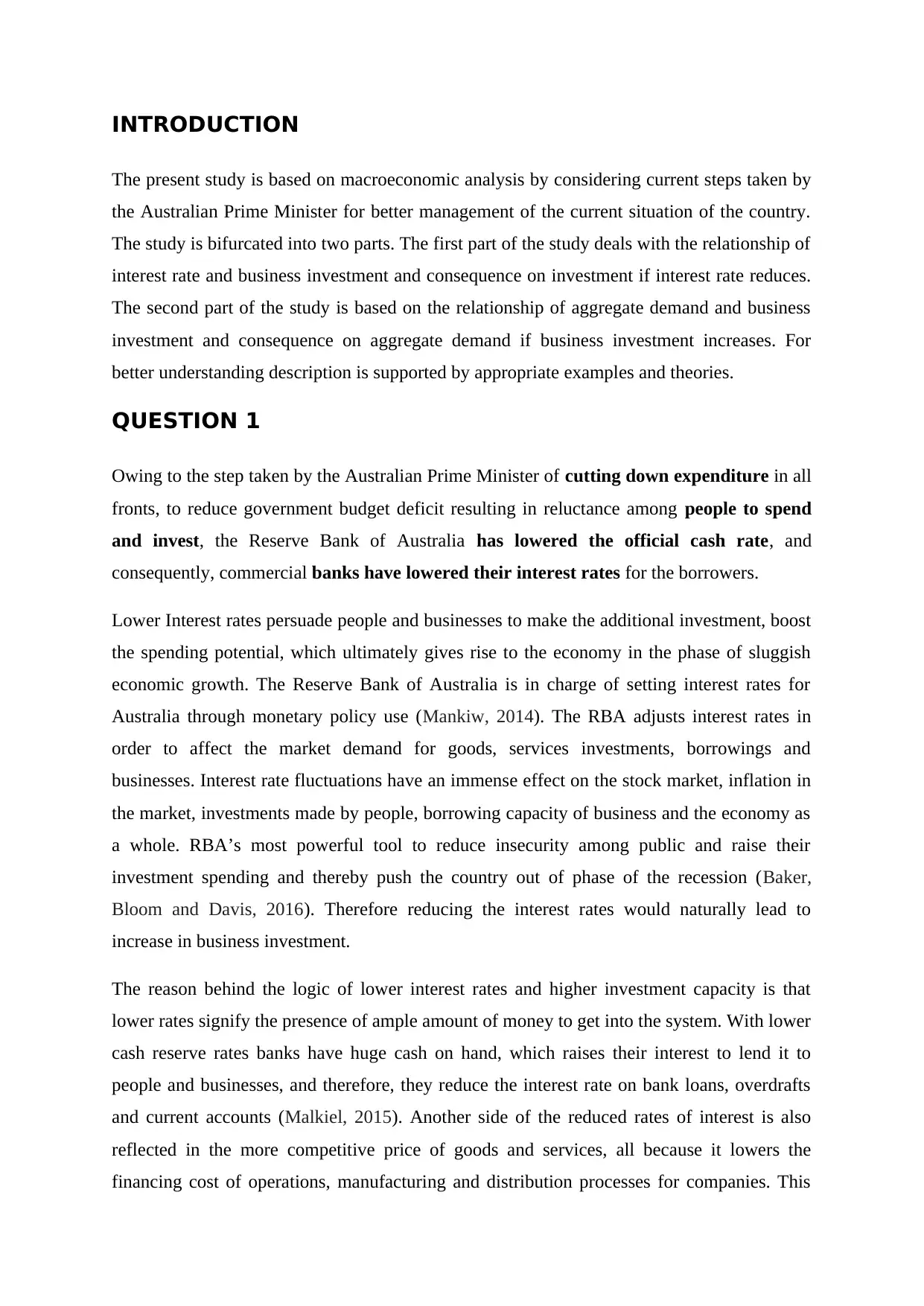
INTRODUCTION
The present study is based on macroeconomic analysis by considering current steps taken by
the Australian Prime Minister for better management of the current situation of the country.
The study is bifurcated into two parts. The first part of the study deals with the relationship of
interest rate and business investment and consequence on investment if interest rate reduces.
The second part of the study is based on the relationship of aggregate demand and business
investment and consequence on aggregate demand if business investment increases. For
better understanding description is supported by appropriate examples and theories.
QUESTION 1
Owing to the step taken by the Australian Prime Minister of cutting down expenditure in all
fronts, to reduce government budget deficit resulting in reluctance among people to spend
and invest, the Reserve Bank of Australia has lowered the official cash rate, and
consequently, commercial banks have lowered their interest rates for the borrowers.
Lower Interest rates persuade people and businesses to make the additional investment, boost
the spending potential, which ultimately gives rise to the economy in the phase of sluggish
economic growth. The Reserve Bank of Australia is in charge of setting interest rates for
Australia through monetary policy use (Mankiw, 2014). The RBA adjusts interest rates in
order to affect the market demand for goods, services investments, borrowings and
businesses. Interest rate fluctuations have an immense effect on the stock market, inflation in
the market, investments made by people, borrowing capacity of business and the economy as
a whole. RBA’s most powerful tool to reduce insecurity among public and raise their
investment spending and thereby push the country out of phase of the recession (Baker,
Bloom and Davis, 2016). Therefore reducing the interest rates would naturally lead to
increase in business investment.
The reason behind the logic of lower interest rates and higher investment capacity is that
lower rates signify the presence of ample amount of money to get into the system. With lower
cash reserve rates banks have huge cash on hand, which raises their interest to lend it to
people and businesses, and therefore, they reduce the interest rate on bank loans, overdrafts
and current accounts (Malkiel, 2015). Another side of the reduced rates of interest is also
reflected in the more competitive price of goods and services, all because it lowers the
financing cost of operations, manufacturing and distribution processes for companies. This
The present study is based on macroeconomic analysis by considering current steps taken by
the Australian Prime Minister for better management of the current situation of the country.
The study is bifurcated into two parts. The first part of the study deals with the relationship of
interest rate and business investment and consequence on investment if interest rate reduces.
The second part of the study is based on the relationship of aggregate demand and business
investment and consequence on aggregate demand if business investment increases. For
better understanding description is supported by appropriate examples and theories.
QUESTION 1
Owing to the step taken by the Australian Prime Minister of cutting down expenditure in all
fronts, to reduce government budget deficit resulting in reluctance among people to spend
and invest, the Reserve Bank of Australia has lowered the official cash rate, and
consequently, commercial banks have lowered their interest rates for the borrowers.
Lower Interest rates persuade people and businesses to make the additional investment, boost
the spending potential, which ultimately gives rise to the economy in the phase of sluggish
economic growth. The Reserve Bank of Australia is in charge of setting interest rates for
Australia through monetary policy use (Mankiw, 2014). The RBA adjusts interest rates in
order to affect the market demand for goods, services investments, borrowings and
businesses. Interest rate fluctuations have an immense effect on the stock market, inflation in
the market, investments made by people, borrowing capacity of business and the economy as
a whole. RBA’s most powerful tool to reduce insecurity among public and raise their
investment spending and thereby push the country out of phase of the recession (Baker,
Bloom and Davis, 2016). Therefore reducing the interest rates would naturally lead to
increase in business investment.
The reason behind the logic of lower interest rates and higher investment capacity is that
lower rates signify the presence of ample amount of money to get into the system. With lower
cash reserve rates banks have huge cash on hand, which raises their interest to lend it to
people and businesses, and therefore, they reduce the interest rate on bank loans, overdrafts
and current accounts (Malkiel, 2015). Another side of the reduced rates of interest is also
reflected in the more competitive price of goods and services, all because it lowers the
financing cost of operations, manufacturing and distribution processes for companies. This
⊘ This is a preview!⊘
Do you want full access?
Subscribe today to unlock all pages.

Trusted by 1+ million students worldwide
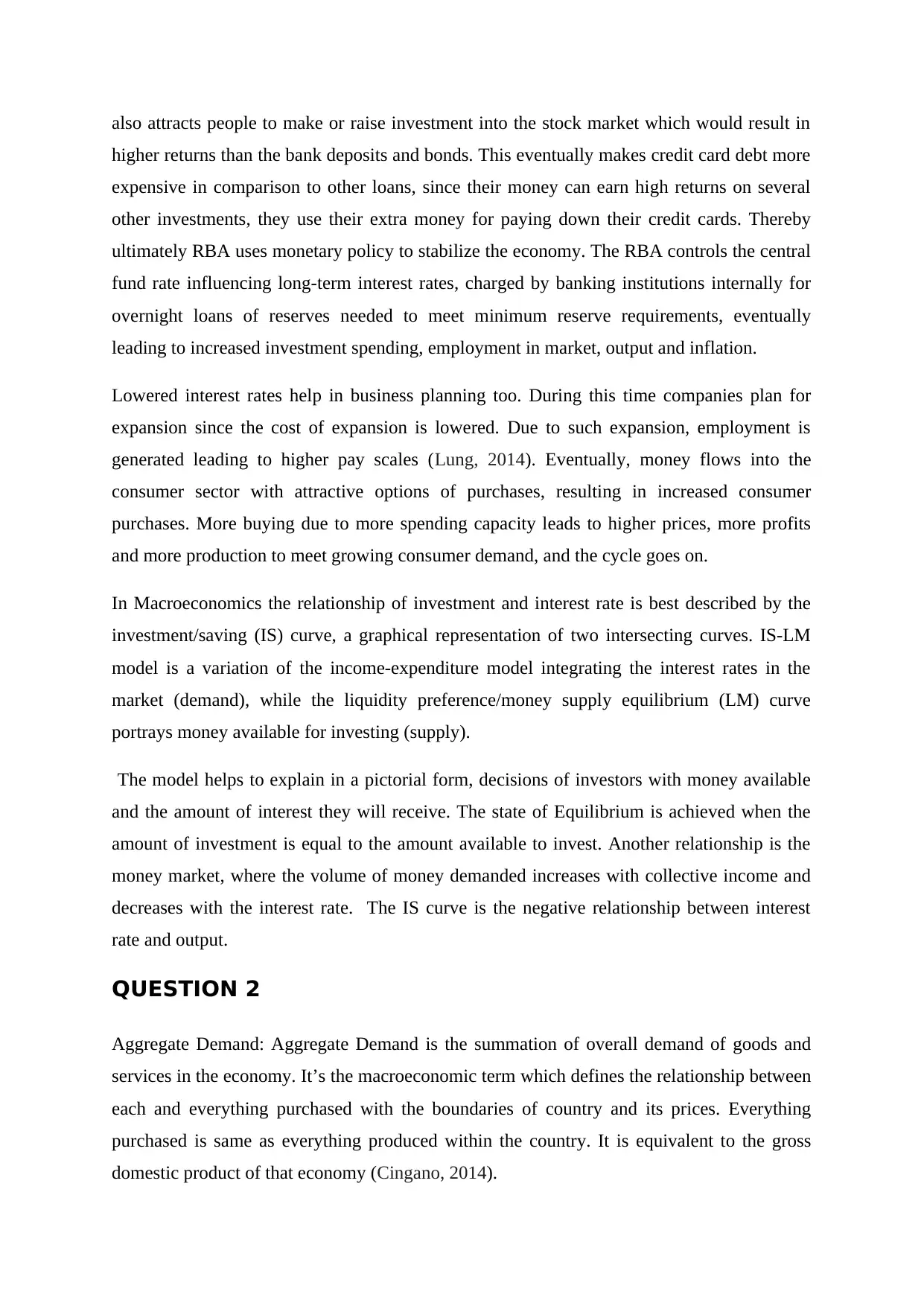
also attracts people to make or raise investment into the stock market which would result in
higher returns than the bank deposits and bonds. This eventually makes credit card debt more
expensive in comparison to other loans, since their money can earn high returns on several
other investments, they use their extra money for paying down their credit cards. Thereby
ultimately RBA uses monetary policy to stabilize the economy. The RBA controls the central
fund rate influencing long-term interest rates, charged by banking institutions internally for
overnight loans of reserves needed to meet minimum reserve requirements, eventually
leading to increased investment spending, employment in market, output and inflation.
Lowered interest rates help in business planning too. During this time companies plan for
expansion since the cost of expansion is lowered. Due to such expansion, employment is
generated leading to higher pay scales (Lung, 2014). Eventually, money flows into the
consumer sector with attractive options of purchases, resulting in increased consumer
purchases. More buying due to more spending capacity leads to higher prices, more profits
and more production to meet growing consumer demand, and the cycle goes on.
In Macroeconomics the relationship of investment and interest rate is best described by the
investment/saving (IS) curve, a graphical representation of two intersecting curves. IS-LM
model is a variation of the income-expenditure model integrating the interest rates in the
market (demand), while the liquidity preference/money supply equilibrium (LM) curve
portrays money available for investing (supply).
The model helps to explain in a pictorial form, decisions of investors with money available
and the amount of interest they will receive. The state of Equilibrium is achieved when the
amount of investment is equal to the amount available to invest. Another relationship is the
money market, where the volume of money demanded increases with collective income and
decreases with the interest rate. The IS curve is the negative relationship between interest
rate and output.
QUESTION 2
Aggregate Demand: Aggregate Demand is the summation of overall demand of goods and
services in the economy. It’s the macroeconomic term which defines the relationship between
each and everything purchased with the boundaries of country and its prices. Everything
purchased is same as everything produced within the country. It is equivalent to the gross
domestic product of that economy (Cingano, 2014).
higher returns than the bank deposits and bonds. This eventually makes credit card debt more
expensive in comparison to other loans, since their money can earn high returns on several
other investments, they use their extra money for paying down their credit cards. Thereby
ultimately RBA uses monetary policy to stabilize the economy. The RBA controls the central
fund rate influencing long-term interest rates, charged by banking institutions internally for
overnight loans of reserves needed to meet minimum reserve requirements, eventually
leading to increased investment spending, employment in market, output and inflation.
Lowered interest rates help in business planning too. During this time companies plan for
expansion since the cost of expansion is lowered. Due to such expansion, employment is
generated leading to higher pay scales (Lung, 2014). Eventually, money flows into the
consumer sector with attractive options of purchases, resulting in increased consumer
purchases. More buying due to more spending capacity leads to higher prices, more profits
and more production to meet growing consumer demand, and the cycle goes on.
In Macroeconomics the relationship of investment and interest rate is best described by the
investment/saving (IS) curve, a graphical representation of two intersecting curves. IS-LM
model is a variation of the income-expenditure model integrating the interest rates in the
market (demand), while the liquidity preference/money supply equilibrium (LM) curve
portrays money available for investing (supply).
The model helps to explain in a pictorial form, decisions of investors with money available
and the amount of interest they will receive. The state of Equilibrium is achieved when the
amount of investment is equal to the amount available to invest. Another relationship is the
money market, where the volume of money demanded increases with collective income and
decreases with the interest rate. The IS curve is the negative relationship between interest
rate and output.
QUESTION 2
Aggregate Demand: Aggregate Demand is the summation of overall demand of goods and
services in the economy. It’s the macroeconomic term which defines the relationship between
each and everything purchased with the boundaries of country and its prices. Everything
purchased is same as everything produced within the country. It is equivalent to the gross
domestic product of that economy (Cingano, 2014).
Paraphrase This Document
Need a fresh take? Get an instant paraphrase of this document with our AI Paraphraser
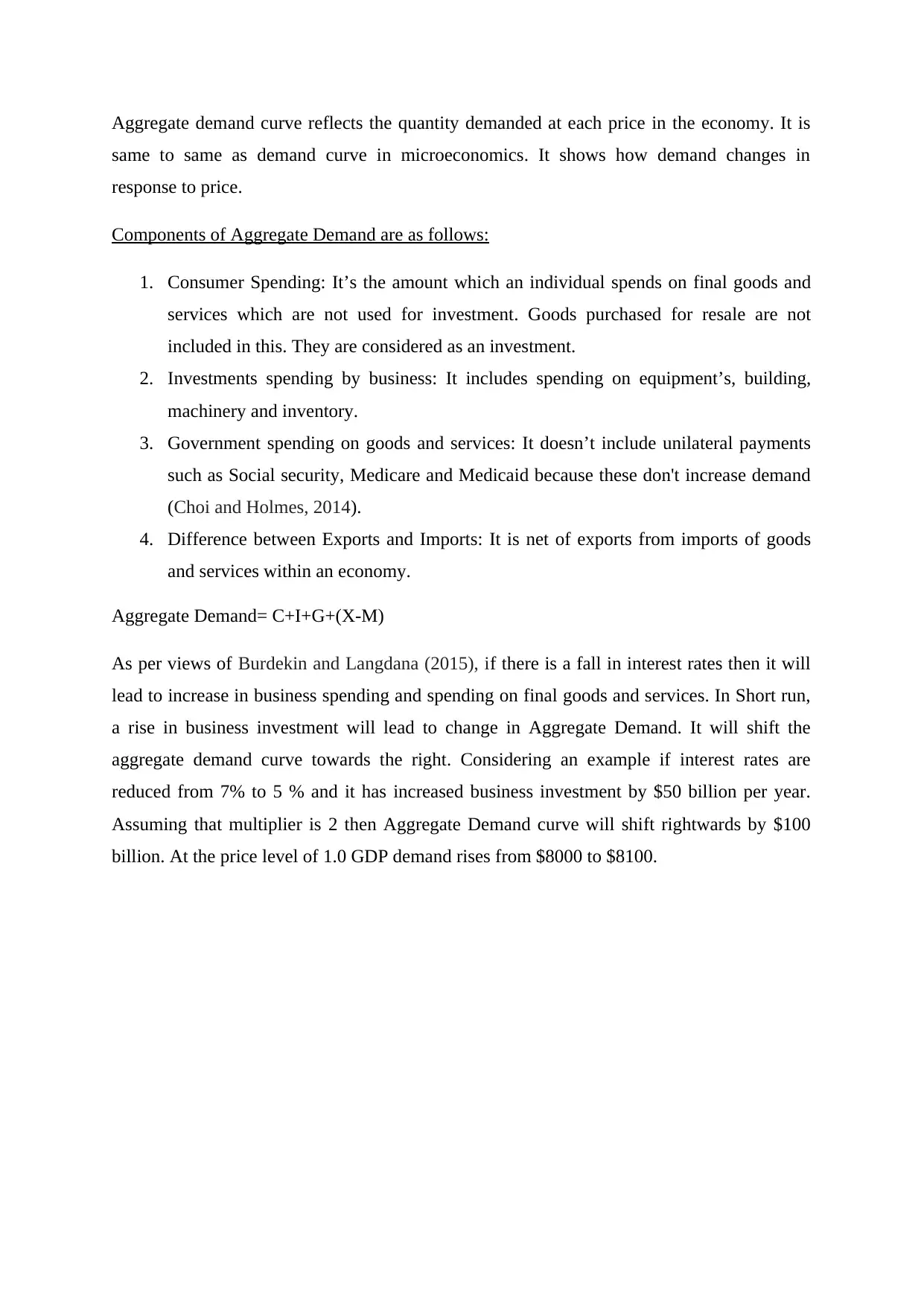
Aggregate demand curve reflects the quantity demanded at each price in the economy. It is
same to same as demand curve in microeconomics. It shows how demand changes in
response to price.
Components of Aggregate Demand are as follows:
1. Consumer Spending: It’s the amount which an individual spends on final goods and
services which are not used for investment. Goods purchased for resale are not
included in this. They are considered as an investment.
2. Investments spending by business: It includes spending on equipment’s, building,
machinery and inventory.
3. Government spending on goods and services: It doesn’t include unilateral payments
such as Social security, Medicare and Medicaid because these don't increase demand
(Choi and Holmes, 2014).
4. Difference between Exports and Imports: It is net of exports from imports of goods
and services within an economy.
Aggregate Demand= C+I+G+(X-M)
As per views of Burdekin and Langdana (2015), if there is a fall in interest rates then it will
lead to increase in business spending and spending on final goods and services. In Short run,
a rise in business investment will lead to change in Aggregate Demand. It will shift the
aggregate demand curve towards the right. Considering an example if interest rates are
reduced from 7% to 5 % and it has increased business investment by $50 billion per year.
Assuming that multiplier is 2 then Aggregate Demand curve will shift rightwards by $100
billion. At the price level of 1.0 GDP demand rises from $8000 to $8100.
same to same as demand curve in microeconomics. It shows how demand changes in
response to price.
Components of Aggregate Demand are as follows:
1. Consumer Spending: It’s the amount which an individual spends on final goods and
services which are not used for investment. Goods purchased for resale are not
included in this. They are considered as an investment.
2. Investments spending by business: It includes spending on equipment’s, building,
machinery and inventory.
3. Government spending on goods and services: It doesn’t include unilateral payments
such as Social security, Medicare and Medicaid because these don't increase demand
(Choi and Holmes, 2014).
4. Difference between Exports and Imports: It is net of exports from imports of goods
and services within an economy.
Aggregate Demand= C+I+G+(X-M)
As per views of Burdekin and Langdana (2015), if there is a fall in interest rates then it will
lead to increase in business spending and spending on final goods and services. In Short run,
a rise in business investment will lead to change in Aggregate Demand. It will shift the
aggregate demand curve towards the right. Considering an example if interest rates are
reduced from 7% to 5 % and it has increased business investment by $50 billion per year.
Assuming that multiplier is 2 then Aggregate Demand curve will shift rightwards by $100
billion. At the price level of 1.0 GDP demand rises from $8000 to $8100.
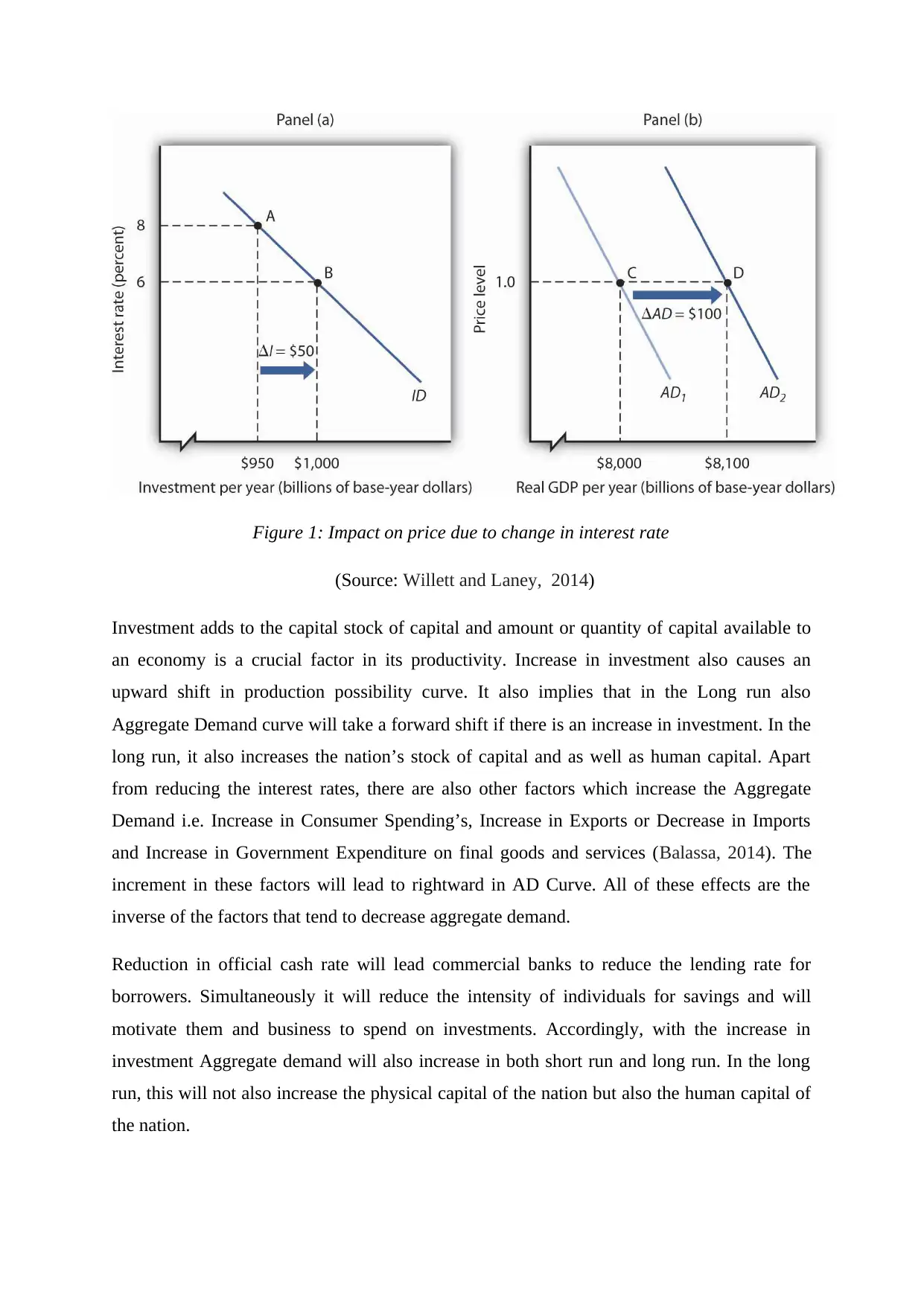
Figure 1: Impact on price due to change in interest rate
(Source: Willett and Laney, 2014)
Investment adds to the capital stock of capital and amount or quantity of capital available to
an economy is a crucial factor in its productivity. Increase in investment also causes an
upward shift in production possibility curve. It also implies that in the Long run also
Aggregate Demand curve will take a forward shift if there is an increase in investment. In the
long run, it also increases the nation’s stock of capital and as well as human capital. Apart
from reducing the interest rates, there are also other factors which increase the Aggregate
Demand i.e. Increase in Consumer Spending’s, Increase in Exports or Decrease in Imports
and Increase in Government Expenditure on final goods and services (Balassa, 2014). The
increment in these factors will lead to rightward in AD Curve. All of these effects are the
inverse of the factors that tend to decrease aggregate demand.
Reduction in official cash rate will lead commercial banks to reduce the lending rate for
borrowers. Simultaneously it will reduce the intensity of individuals for savings and will
motivate them and business to spend on investments. Accordingly, with the increase in
investment Aggregate demand will also increase in both short run and long run. In the long
run, this will not also increase the physical capital of the nation but also the human capital of
the nation.
(Source: Willett and Laney, 2014)
Investment adds to the capital stock of capital and amount or quantity of capital available to
an economy is a crucial factor in its productivity. Increase in investment also causes an
upward shift in production possibility curve. It also implies that in the Long run also
Aggregate Demand curve will take a forward shift if there is an increase in investment. In the
long run, it also increases the nation’s stock of capital and as well as human capital. Apart
from reducing the interest rates, there are also other factors which increase the Aggregate
Demand i.e. Increase in Consumer Spending’s, Increase in Exports or Decrease in Imports
and Increase in Government Expenditure on final goods and services (Balassa, 2014). The
increment in these factors will lead to rightward in AD Curve. All of these effects are the
inverse of the factors that tend to decrease aggregate demand.
Reduction in official cash rate will lead commercial banks to reduce the lending rate for
borrowers. Simultaneously it will reduce the intensity of individuals for savings and will
motivate them and business to spend on investments. Accordingly, with the increase in
investment Aggregate demand will also increase in both short run and long run. In the long
run, this will not also increase the physical capital of the nation but also the human capital of
the nation.
⊘ This is a preview!⊘
Do you want full access?
Subscribe today to unlock all pages.

Trusted by 1+ million students worldwide
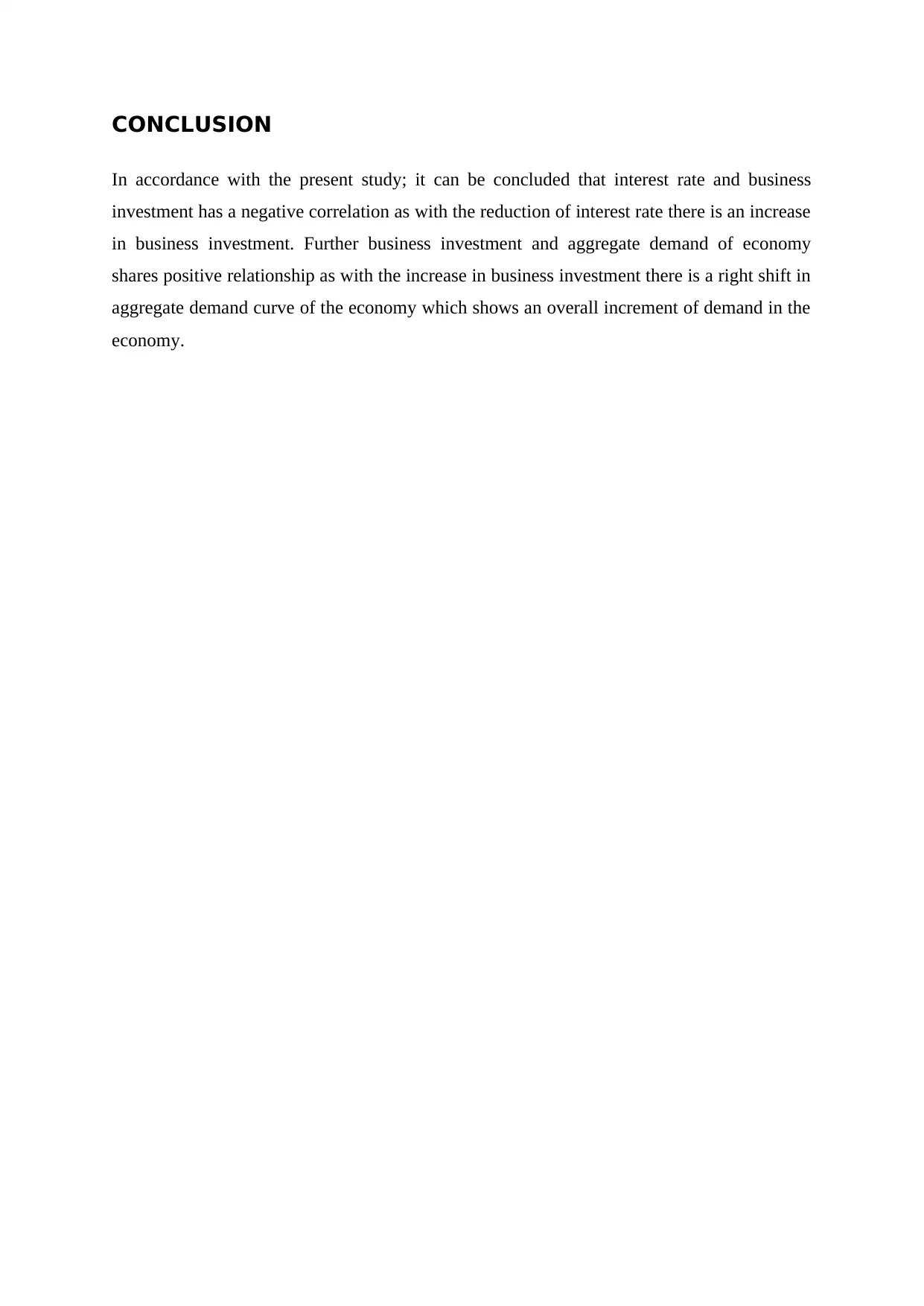
CONCLUSION
In accordance with the present study; it can be concluded that interest rate and business
investment has a negative correlation as with the reduction of interest rate there is an increase
in business investment. Further business investment and aggregate demand of economy
shares positive relationship as with the increase in business investment there is a right shift in
aggregate demand curve of the economy which shows an overall increment of demand in the
economy.
In accordance with the present study; it can be concluded that interest rate and business
investment has a negative correlation as with the reduction of interest rate there is an increase
in business investment. Further business investment and aggregate demand of economy
shares positive relationship as with the increase in business investment there is a right shift in
aggregate demand curve of the economy which shows an overall increment of demand in the
economy.
Paraphrase This Document
Need a fresh take? Get an instant paraphrase of this document with our AI Paraphraser
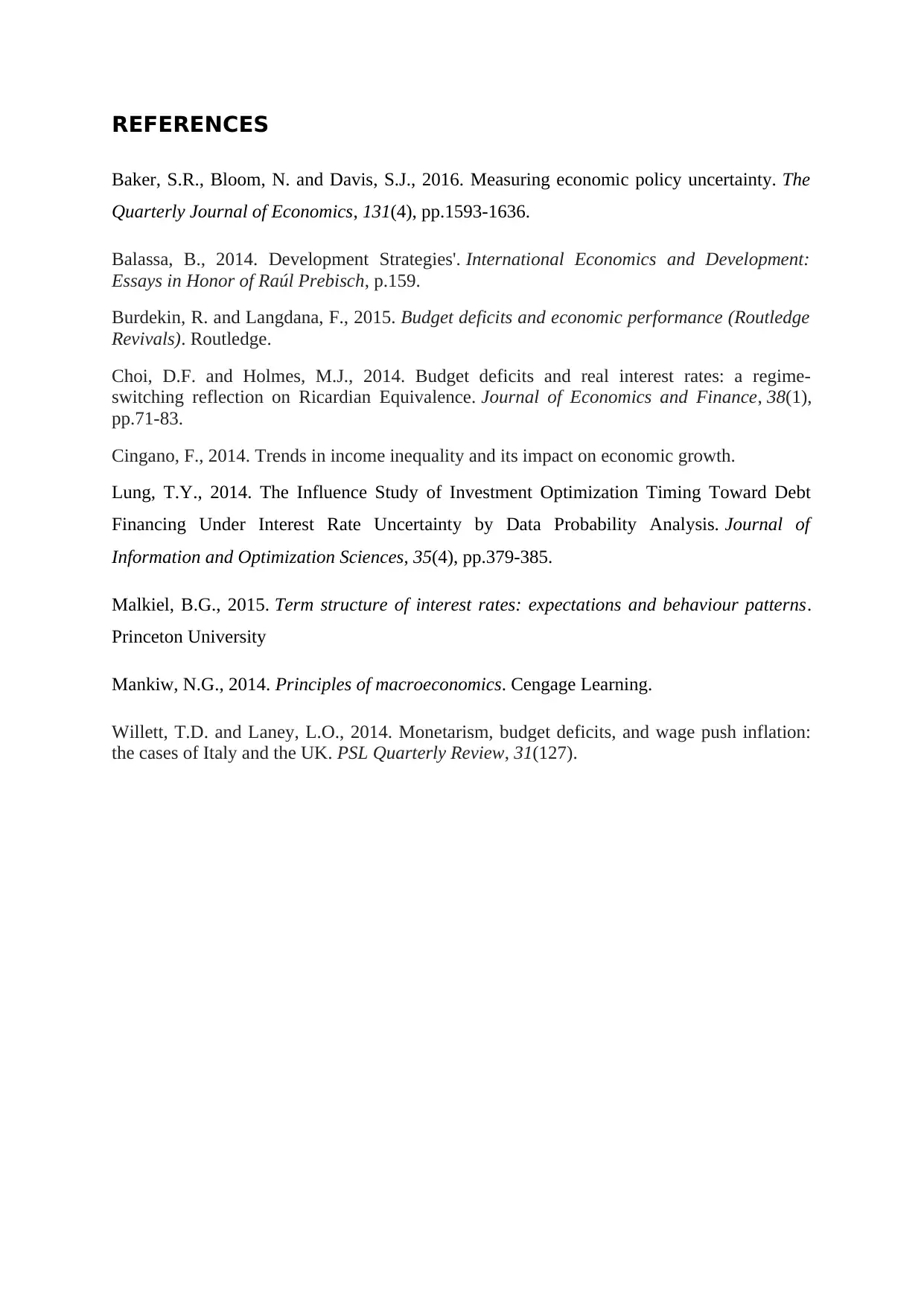
REFERENCES
Baker, S.R., Bloom, N. and Davis, S.J., 2016. Measuring economic policy uncertainty. The
Quarterly Journal of Economics, 131(4), pp.1593-1636.
Balassa, B., 2014. Development Strategies'. International Economics and Development:
Essays in Honor of Raúl Prebisch, p.159.
Burdekin, R. and Langdana, F., 2015. Budget deficits and economic performance (Routledge
Revivals). Routledge.
Choi, D.F. and Holmes, M.J., 2014. Budget deficits and real interest rates: a regime-
switching reflection on Ricardian Equivalence. Journal of Economics and Finance, 38(1),
pp.71-83.
Cingano, F., 2014. Trends in income inequality and its impact on economic growth.
Lung, T.Y., 2014. The Influence Study of Investment Optimization Timing Toward Debt
Financing Under Interest Rate Uncertainty by Data Probability Analysis. Journal of
Information and Optimization Sciences, 35(4), pp.379-385.
Malkiel, B.G., 2015. Term structure of interest rates: expectations and behaviour patterns.
Princeton University
Mankiw, N.G., 2014. Principles of macroeconomics. Cengage Learning.
Willett, T.D. and Laney, L.O., 2014. Monetarism, budget deficits, and wage push inflation:
the cases of Italy and the UK. PSL Quarterly Review, 31(127).
Baker, S.R., Bloom, N. and Davis, S.J., 2016. Measuring economic policy uncertainty. The
Quarterly Journal of Economics, 131(4), pp.1593-1636.
Balassa, B., 2014. Development Strategies'. International Economics and Development:
Essays in Honor of Raúl Prebisch, p.159.
Burdekin, R. and Langdana, F., 2015. Budget deficits and economic performance (Routledge
Revivals). Routledge.
Choi, D.F. and Holmes, M.J., 2014. Budget deficits and real interest rates: a regime-
switching reflection on Ricardian Equivalence. Journal of Economics and Finance, 38(1),
pp.71-83.
Cingano, F., 2014. Trends in income inequality and its impact on economic growth.
Lung, T.Y., 2014. The Influence Study of Investment Optimization Timing Toward Debt
Financing Under Interest Rate Uncertainty by Data Probability Analysis. Journal of
Information and Optimization Sciences, 35(4), pp.379-385.
Malkiel, B.G., 2015. Term structure of interest rates: expectations and behaviour patterns.
Princeton University
Mankiw, N.G., 2014. Principles of macroeconomics. Cengage Learning.
Willett, T.D. and Laney, L.O., 2014. Monetarism, budget deficits, and wage push inflation:
the cases of Italy and the UK. PSL Quarterly Review, 31(127).
1 out of 8
Related Documents
Your All-in-One AI-Powered Toolkit for Academic Success.
+13062052269
info@desklib.com
Available 24*7 on WhatsApp / Email
![[object Object]](/_next/static/media/star-bottom.7253800d.svg)
Unlock your academic potential
Copyright © 2020–2025 A2Z Services. All Rights Reserved. Developed and managed by ZUCOL.





